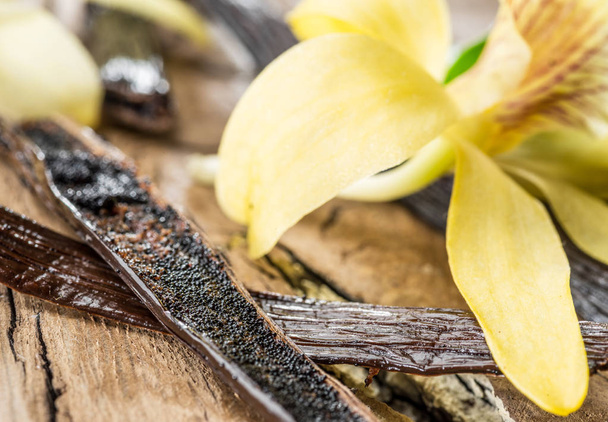By djavanilla September 5, 2020
Differentiating Between Bourbon Planifolia Vanilla and Tahitian Vanilla
Vanilla is a highly coveted spice that comes in various varieties, each with distinct flavors, aromas, and uses. Among the most popular are Bourbon Planifolia vanilla and Tahitian vanilla. Though both types come from the vanilla orchid, they offer different sensory experiences and are cultivated in different regions. Let’s explore the key differences between these two varieties.
1. Origins and Cultivation
Planifolia Vanilla: This variety, also known simply as Bourbon vanilla, comes from Vanilla planifolia orchids. It is primarily grown in Indonesia, Réunion, and other parts of the Indian Ocean. The name “Bourbon” is derived from the old name of Réunion Island, which was known as Île Bourbon. Bourbon vanilla is the most common type of vanilla, making up around 75-80% of the world’s vanilla production.
Tahitian Vanilla: Tahitian vanilla, derived from the Vanilla tahitensis orchid, is predominantly grown in French Polynesia, specifically the islands of Tahiti. It is considered a unique species that likely resulted from the hybridization of Vanilla planifolia and another wild species. Tahitian vanilla is much rarer and represents only a small portion of the global vanilla supply.
2. Flavor Profile
Planifolia Vanilla: Known for its rich, creamy, and bold flavor, Bourbon vanilla is often described as having strong, classic vanilla notes with undertones of chocolate and spice. Its sweet and full-bodied taste makes it the go-to variety for desserts like ice creams, pastries, and cakes. The flavor is deep and pronounced, lingering on the palate.
Tahitian Vanilla: Tahitian vanilla, in contrast, offers a lighter, more floral and fruity profile. It has delicate notes of cherry, anise, and licorice, making it more aromatic and softer in flavor than Bourbon vanilla. Its subtler nature makes it a popular choice in gourmet dishes, perfumes, and cosmetic products where a less overpowering vanilla presence is desired.
3. Aroma
Planifolia Vanilla: The aroma of Bourbon vanilla is warm, sweet, and intensely aromatic. It has a comforting, traditional scent that is commonly associated with vanilla-based products worldwide.
Tahitian Vanilla: Tahitian vanilla boasts a more floral and complex fragrance. Its scent is fruity and exotic, often described as being more perfumed compared to Bourbon vanilla. Because of this, it is frequently used in high-end perfumes and luxury goods.
4. Appearance
Bourbon Vanilla: The beans of Bourbon vanilla are generally longer, thinner, and darker. They are moist, oily to the touch, and contain a higher concentration of vanillin, the compound responsible for vanilla’s signature flavor.
Tahitian Vanilla: Tahitian vanilla beans tend to be shorter, plumper, and more delicate. They are also lighter in color and contain less vanillin than Bourbon vanilla, which is why their flavor leans toward the more floral and fruity side.
“The distinction between Bourbon Planifolia vanilla and Tahitian vanilla lies not only in their botanical species but also in their sensory profiles. Bourbon vanilla offers a rich, robust flavor, ideal for baked goods, while Tahitian vanilla, with its floral and fruity notes, is more suited for delicate culinary applications. Their unique characteristics reflect the regions they are grown in and the specific pollination and curing methods used.”
5. Culinary Uses
Bourbon Vanilla: Because of its robust flavor, Bourbon vanilla is a versatile ingredient in both sweet and savory dishes. It is ideal for baked goods like cookies, cakes, and custards, as well as ice creams, sauces, and beverages. Its strength ensures that the vanilla flavor stands out, even in dishes with other bold ingredients.
Tahitian Vanilla: Tahitian vanilla’s softer, more nuanced flavor makes it perfect for delicate dishes that require a more refined touch. It is often used in light creams, custards, fruit-based desserts, and exotic sauces. Additionally, due to its aromatic qualities, Tahitian vanilla is favored in gourmet and high-end culinary creations.
While Bourbon Planifolia vanilla and Tahitian vanilla share a common origin, their differences in flavor, aroma, and application are notable. Bourbon vanilla’s rich and bold character makes it ideal for traditional desserts and strong flavors, while Tahitian vanilla’s delicate, floral notes shine in lighter, more refined dishes. Each variety offers its own unique experience, allowing chefs, bakers, and perfumers to choose the best vanilla for their specific needs. Whether you prefer the full-bodied essence of Bourbon vanilla or the exotic aroma of Tahitian vanilla, both are essential to the diverse world of flavor.
